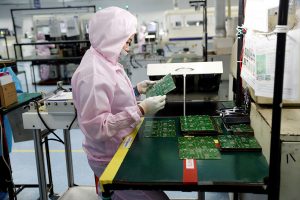Chip industry sees US reshoring of semicondutor production diversifying sources of supply

THE Semiconductor and Electronics Industries in the Philippines Foundation, Inc. (SEIPI) said the new law passed in Washington seeking to increase chip production within the US will diversify the sources of supply, to the benefit of electronics producers here.
Danilo C. Lachica, SEIPI president, said in a Viber message that the recently signed Creating Helpful Incentives to Produce Semiconductors for America (CHIPS) and Science Law will be positive for Philippine companies, which import chips for the assembly of electronic products.
“There are no worries. The CHIPS Law will diversify the source of semiconductor wafers, which the Philippines import for assembly, test and packaging. (The law) should be a positive effect,” Mr. Lachica said.
Last month, US President Joe Biden signed the CHIPS Law to preserve the US ability to produce semiconductors, which have been outsourced to Asia for decades.
The law provides over $52 billion for US semiconductor research, manufacturing, and workforce development. Of the total, some $39 billion has been set aside for manufacturing incentives.
Jesus Carlos P. Villaseñor, Procurement and Supply Institute of Asia chairman and chief executive officer, said in a recent television interview that the CHIPS Law provides an incentive for US companies to bring their production back from Asia.
The law “will mandate and incentivize US companies to bring their manufacturing, especially on semiconductors, electronics, and technology, back to America,” Mr. Villaseñor said.
“There is a reverse globalization happening. I think it is worthwhile for them to do it because they have experienced this in the past. This will affect a lot of those dependent to having the manufacturing base in their own respective locations like in Southeast Asia, including the Philippines,” he added.
Rizal Commercial Banking Corp. Chief Economist Michael L. Ricafort said that the law would help stabilize supply following recent semiconductor shortages and supply chain disruptions.
“This will ensure self-sufficiency for electronic products from upstream to downstream in the electronics value chain, especially if there are disruptions in the global supply chains, (based on) the lessons from 2020-2021,” Mr. Ricafort said.
However, Mr. Ricafort noted that the CHIPS Law might reduce demand for outsourced electronics from countries such as the Philippines.
“(The law) would lead to less demand from outsourced semiconductors/electronics especially from Asian countries, including the Philippines, in terms of less reliance on imported semiconductors/electronic components and products by the US, especially felt if there is a global oversupply,” Mr. Ricafort said.
“Nevertheless, production costs remain relatively lower by importing from Asian countries, so it is still economical and practical in terms of cost savings for the US to still continue importing semiconductors/electronics from Asian countries,” he added.
As of July, the semiconductor and electronics industry remained the Philippines’ top exporter at $26.51 billion, up 1.9% year on year, accounting for 59.25% of the export total, SEIPI estimates show.
SEIPI is targeting 10% growth for the Philippine semiconductor and electronics industries in 2022. — Revin Mikhael D. Ochave




